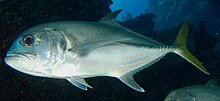Caranx
|
Caranx Temporal range: 55–0 Ma Eocene to Present |
|
|---|---|
 |
|
| The horse eye jack, Caranx latus | |
| Scientific classification | |
| Kingdom: | Animalia |
| Phylum: | Chordata |
| Class: | Actinopterygii |
| Order: | Perciformes |
| Suborder: | Percoidei |
| Superfamily: | Percoidea |
| Family: | Carangidae |
| Genus: |
Caranx Lacépède, 1801 |
| Type species | |
|
Caranx carangua Lacépède, 1801 |
|
| Species | |
|
See text for species |
|
| Synonyms | |
See text for species
Caranx is a genus of tropical to subtropical marine fishes in the jack family Carangidae, commonly known as jacks, trevallies and kingfishes. They are moderate- to large-sized, deep-bodied fishes which are distinguished from other carangid genera by specific gill raker, fin ray and dentition characteristics. The genus is represented in the Pacific, Indian and Atlantic Oceans, inhabiting both inshore and offshore regions, ranging from estuaries and bays to deep reefs and offshore islands. All species are powerful predators, taking a variety of fish, crustaceans and cephalopods, while they in turn are prey to larger pelagic fishes and sharks. A number of fish in the genus have a reputation as powerful gamefish and are highly sought by anglers. They often make up high amounts of the catch in various fisheries, but are generally considered poor to fair table fishes.
The genus Caranx is one of 30 currently recognised genera of fish in the jack and horse mackerel family Carangidae, which are perciform fishes in the suborder Percoidei. The species has long been placed in the subfamily Caranginae (or tribe Carangini), with modern molecular and genetic studies indicating this subdivision is acceptable, and Caranx is well defined as a genus.Phylogenetically, the monotypic genus of Gnathanodon is most closely related to Caranx; and indeed its sole member was once classified under Caranx.
...
Wikipedia
